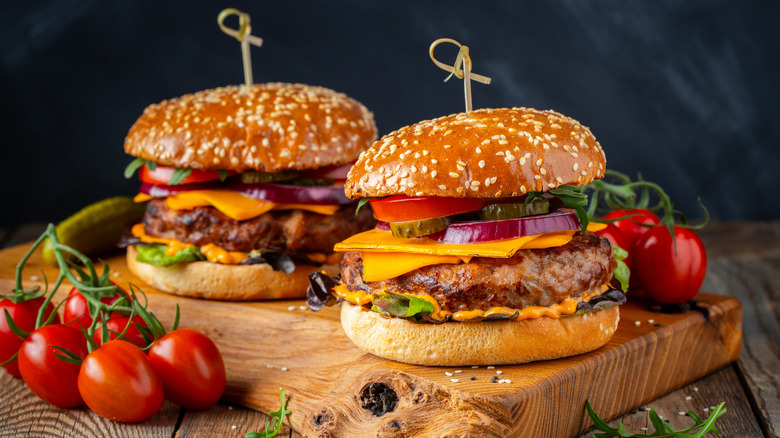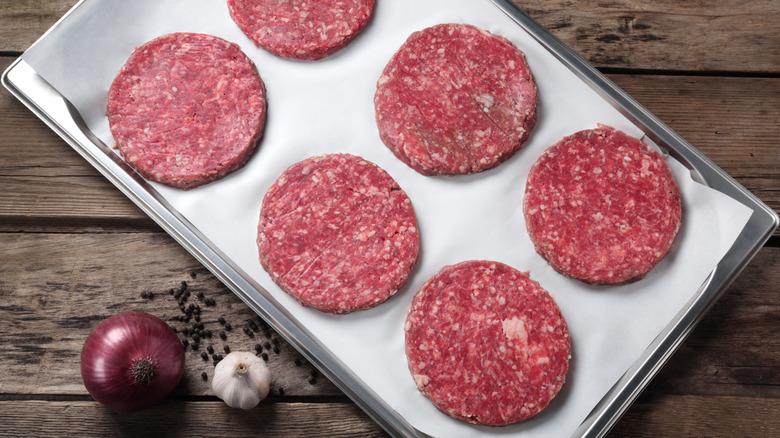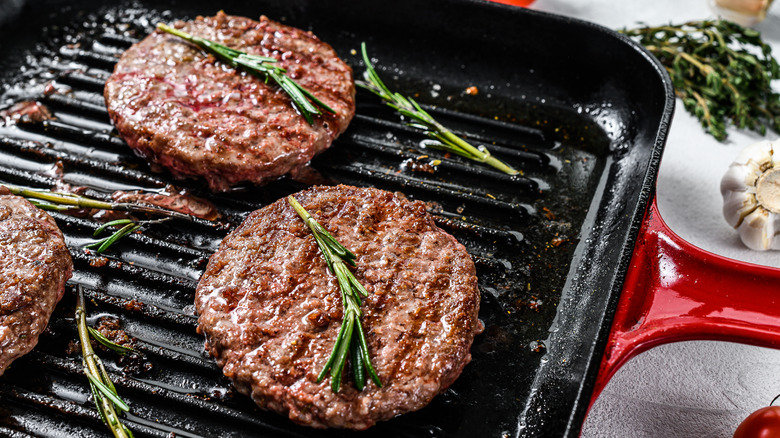The Fuss-Free Restaurant Burger Technique That's Perfect If You Don't Feel Like Grilling
Backyard cookouts are a tell-tale sign that summer is near. With the sun shining down and the hickory smell of patties cooking on an open flame, there's nothing better to kickstart the season. However, the picturesque scenery may not reflect the tricky tango occurring within the grill, specifically between the patties and the grates.
Grilling is a complex art to master, especially when it comes to adequate heating. Intense flames can turn the succulent patty you intended to eat into a charred hockey puck, whereas low heat can glue the burger to the grates and cause them to break apart. Unfortunately, the grates themselves can be an issue, too. Wiry bristles from a poorly maintained brush used to clean the grill are unwanted ingredients that, when ingested, can cause digestive and bodily harm. Uneven cooking on the grill can lead to food-borne illness and tasteless or dry burgers. So, where does the secret to making the best homemade burgers lie? Surprisingly, it's inside the kitchen oven.
Your oven harbors many special abilities for crafting the ultimate cheeseburger. For starters, it supplies an even source of heat on all sides to create a decent crust without loss of moisture within. It also allows you to cook multiple patties at a time instead of fitting three or four in a stove-top skillet. And, with the help of a proper broiling pan, your burgers can cook without added oils or unnecessary fats. Most importantly, baked patties require practically zero effort.
How to make the best oven-baked burgers
One of the best perks of broiled burgers is that they don't require much monitoring. Compared to traditional grilling or pan-frying, baked patties don't need to be constantly flipped, tossed, or turned. Instead, they can be left alone, except for a midway rotation. Still, there are some important steps to remember when swapping your grill for the oven.
Determining how hot and long your burgers should be broiled is an essential first step. For those who prefer a leaner cut of meat, ensure your oven is in the "bake" setting rather than "broil." Ground beef with a low-fat content tends to cook faster and drier if not baked or marinated correctly. To prevent this, lean beef patties should be coated in sauce, seasoning, and oil marinades to seal in the burger's moisture. Remove them from the heat just before your desired temperature is reached.
Beef with a higher fat ratio should be broiled. Compared to baking, broiling produces an intense heat flow that moves from the top down. This can create an ideal charring effect like a grill, minus the potential loss of a burger between the grates. Seasonings can be included, but because of the added fat content, it isn't necessary to cover it in a liquid mixture. Make a thumb-sized impression in the center prior to broiling to keep it from pillowing and cooking unevenly. Then, broil for a few minutes on the top rack before flipping and repeating.
Cast-iron skillets are a great tool for cooking patties
Despite how easy it can be to cook patties in the oven, many opt to use the classic pan-frying method for homemade burgers. The pros? Cast-iron skillets are smaller and known for regulating heat well. This property allows the meat to simmer in its juice without fear of being too thin or spread out in a pan, especially if the patties are of a higher quality. It also allows for easier temperature monitoring, whereas in an oven, the burgers are baked or broiled in a pan simultaneously. And if your skillet is designed with alternating ridges, they can be seared with their classic markings.
However, there are elements the oven and stove can't replicate, such as the hickory smoke and taste associated with a charcoal grill. That said, enjoying the sunshine while grilling is still perfectly fine. One trick to ensuring your burger refrains from dehydration or flame flare-up is using that same cast-iron skillet from the stovetop on the grates. It can prevent odors from spreading throughout the house (thanks, salmon burgers) and provide even cooking without fear of stoking the grill's flames.
Once the burgers have been seared to their desired temperature, add vegetables to the pan to roast in the seasoned leftover juices. Cast-iron skillets protect the grates from becoming caked in fat, grease, and other food remnants. This can lead to easier cleanup without harsh chemicals or wiry brushes.


